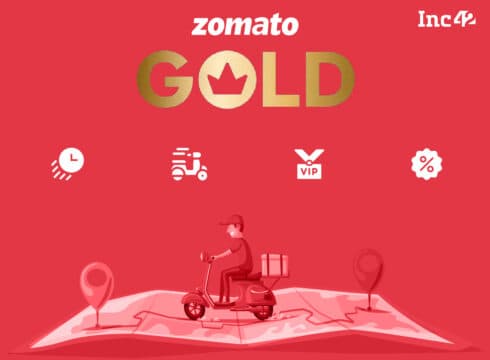Zomato discontinued its loyalty programme in August last year but reintroduced Zomato Gold last month amid apprehensions that the lack of such a programme can benefit its rival Swiggy
JM Financial took into account four scenarios for Gold membership and concluded that the most likely outcome would be an increase in order volume along with revenue/ cost efficiencies
The brokerage retained its ‘buy’ rating on Zomato and cut price target to INR 100 from INR 126 earlier, over 90% higher than its last close
Inc42 Daily Brief
Stay Ahead With Daily News & Analysis on India’s Tech & Startup Economy
At a time when the relaunch of foodtech giant Zomato’s customer loyalty programme ‘Zomato Gold’ has triggered debates about its impact on the growth margins, JM Financial has weighed in on the issue saying that it can lead to an increase in order volume.
In a research note, the brokerage said that while the company believes that the short-term negative impact of free deliveries due to the programme will be offset by improvements in other revenue and fixed and variable cost drivers, there is complexity in forecasting margins, which has kept the debate raging.
“Basis the initial feedback from a small sample set of customers and the management commentary of visible green shoots in the form of an increase in app opens post the launch, we believe, ceteris paribus, that the Gold launch should certainly drive up order volume,” it said.
Zomato Gold was first launched in 2017 and after being rebranded a few times, the programme was discontinued in 2022. However, Zomato reintroduced Zomato Gold in late January this year as a replacement to Pro Plus membership, which was stopped in August last year.
The absence of a membership programme had become a cause of concern for many investors given Zomato’s main competitor Swiggy had one such programme, Swiggy One.
During its Q3 FY23 earnings call, Zomato’s management admitted that the absence of a membership program impacted its Q2 results and, to some extent, played a role in customer attrition and decrease in frequency of orders.
However, after Zomato reported a net loss of INR 346.6 Cr in Q3 FY23, which widened both on a year-on-year (YoY) and quarter-on-quarter (QoQ) basis, questions were raised about the possible impact of free deliveries on its profitability target, which is currently the main focus of the company.
JM Financial said it believes that Zomato has enough levers both on revenue (restaurant commission take-rates and ad income) as well as on variable cost (such as the closure of operations in 225 cities) that would partially negate the impact of the free delivery benefit for Gold members.
The brokerage took into account four scenarios that Gold membership can lead to – flat order volume with no revenue/cost efficiencies, flat order volume with revenue/cost efficiencies, increase in order volume but no revenue/cost efficiencies, and increase in order volume along with revenue/cost efficiencies.
Based on its study, JM Financial concluded that the most likely outcome of the loyalty programme would be an increase in Zomato’s order volume along with revenue/ cost efficiencies.
Besides, the brokerage raised its EBITDA margin estimates on Zomato by 160 basis points (bps)/ 220 bps over FY23/FY24 due to lower-than-estimated operating losses in Q3.
“We continue to remain bullish on the company’s long-term prospects in the hyperlocal delivery space as we believe it is well-positioned to benefit from robust industry tailwinds such as improving tech penetration and rising income share of digitally native millennials/GenZ,” the brokerage added.
With a ‘buy’ rating on the stock, JM Financial cut its price target on Zomato to INR 100 from INR 126 earlier, over 90% higher than its close on Friday. Shares of Zomato ended Friday’s session at INR 51.85, up 0.9% on the BSE.
{{#name}}{{name}}{{/name}}{{^name}}-{{/name}}
{{#description}}{{description}}...{{/description}}{{^description}}-{{/description}}
Note: We at Inc42 take our ethics very seriously. More information about it can be found here.


